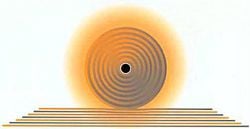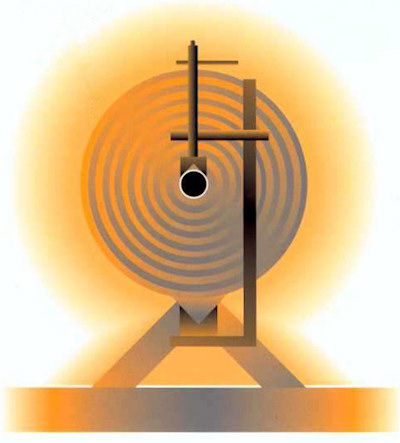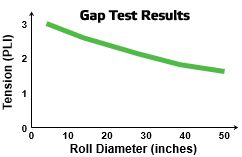Measuring wound-in tension - WIT-WOT and gap test methods

What is wound-in tension?
A roll of paper is a mechanical system. It consists of many layers of paper wound on top of each other with some degree of tension wound into each layer. This tension creates a compressive force, which, when combined with the coefficient of friction between layers of paper, forms the mechanism that holds the roll together. The distribution of tensile and compressive stresses from the core to the outside of the roll is the roll structure. Wound-in tension controls the magnitude of these forces. It is the most important component for proper roll structure, therefore it is vital for mills to track and control wound-in tension.
How is wound-in tension measured?
There are a variety of methods for studying roll structure. Most methods measure hardness, layer-to-layer compression or density – all of which are created by wound-in tension, but they are not wound-in tension. At the present time, there are only two accurate methods to measure wound-in tension: the WIT-WOT and the Gap Test.
The WIT-WOT test method
WIT-WOT stands for Wound-In Tension and Wound-Off Tension and is the most accurate method to measure wound-in tension. Using a specially designed test-winder, a sophisticated computer analysis system measures the tension wound into the roll as its being unwound. By collecting thousands of data points, even the most minute problems can be detected. This test is limiting and can be expensive, however, because rolls must be shipped to a research facility. For an accurate and reliable method that can be performed on the plant floor, the Gap Test is the answer.
The Gap Test method
A simple procedure to learn and perform, the Gap Test remains the foremost method for in-mill analysis that provides quick results. It can be used for quality control, winder calibration and tune-up, or as an analytical troubleshooting tool. The procedure for the test is as follows:
- Remove the test roll from the winder, secure the loose end of the sheet and place the roll on the floor. When selecting test rolls, it is important to analyze rolls from different positions on the winder to determine the quality of the winding process across the width of the machine.
- Draw a radial line from the outer most edge of the core of the roll. This will be the guide for making test interval diameters in the roll. Test intervals will vary according to the diameter of the roll and the degree of resolution required. For a basic check on general wound-in tension trends, a 1/2-inch interval is sufficient. For a more detailed analysis or to pinpoint a specific problem, tests can be performed at more frequent intervals. A common intermediate interval is 1/4-inch.
- Slice the diameter of the roll to the first mark using a utility knife.
- Measure and record the roll diameter.
- Carefully slice one sheet across the width of the roll. This cut will release the tension, and the sheet will split apart.
- Measure the gap between the cut sheets, record the data and then slice to the next interval point.

Modified testing procedure
As roll diameter and nip intensity continue to decrease and the nip area increases, slippage can occur, impairing the results (see above figure). To help retain wound-in tension and ensure accurate and relevant gap measurements, an alternate method for staging the Gap Test involves a simple clamping device that stabilizes the roll.
The roll is elevated on a sawhorse-type stand when it has been reduced to approximately 30 inches in diameter. A core-sized aluminum tube is inserted through the roll’s core. A C-clamp fastened to the aluminum tube and the sawhorse secures the roll in place and prevents slippage. While some grades are more prone to slippage than others, this clamping method helps ensure Gap Test accuracy on all types of paper.

To ensure accurate and relevant measurements, the roll is elevated on a sawhorse and a clamping device is employed. This stabilizes the roll and prevents slippage.
The final analysis
The final step in the Gap Test is to analyze the data:
- Calculate the strain for each of recordings: [Gap/(pi x Diameter)] x 100
- Determine actual tension: Wound-In tension (pounds per linear inch) = [Gap/(pi x Diameter)] x Caliper x Modulus of elasticity (Caliper can be measured with a micrometer; laboratory testing determines modulus of elasticity.)
- Graph the results – a computer can make the task easier by automating the calculations and plotting the data.

Because wound-in tension plays such a key role in maintaining roll quality, it is vital for mills to be able to track and manage their operation’s ability to maintain adequate levels of tension in finished rolls. The Gap Test offers a quick, easy and cost-effective solution.
For more information on measuring wound roll quality, contact your Valmet representative.